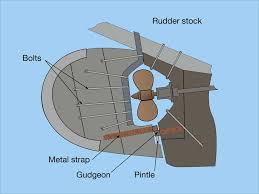مقدمة
Understanding sailboat rudders and steering systems is essential for navigating the waters with confidence and safety. Rudders serve as the primary controls for a vessel’s direction, impacting its efficiency and performance. This guide delves into the different types of sailboat rudders, their mechanics, and the intricacies of steering systems, providing valuable insights for both novice and experienced sailors.
Sailboat Rudder Types
Rudders come in a variety of forms, each designed to enhance a boat’s steering capabilities differently. They can primarily be categorized based on their structure and position.
- Inboard & Outboard Rudders: Inboard rudders are integrated within the hull, while outboard rudders extend outward from the vessel’s back.
- Balanced vs. Unbalanced: Balanced rudders distribute the force more evenly, easing steering efforts, while unbalanced rudders can make steering significantly heavier.
- Mounting Types: Rudders may be keel-hung, skeg-hung, transom-hung, or spade, each offering unique benefits and drawbacks regarding handling and safety.
Rudder Breakdown
Understanding these rudder types is crucial for choosing the right sailboat. Here’s a brief look at each:
| Rudder Type | Description | Use Case |
| Keel-Hung Rudder | Attached to a full-length keel for stability. | Ideal for older cruising vessels requiring heavy displacement. |
| Skeg-Hung Rudder | Supported by a fin (skeg), offering protection and efficiency. | Common in offshore cruisers valuing both speed and safety. |
| Transom-Hung Rudder | Affixed to the transom, easy to remove and repair. | Typical on dinghies, preferred for small crafts. |
| Spade Rudder | A streamlined fin design that enhances maneuverability. | Typical on racing yachts for speed and agility. |
Rudder Balance and Its Importance
The balance of a rudder plays a substantial role in how easily it can be steered. A balanced rudder has part of its blade positioned in front of its turning axis, which helps counteract water pressure during turns, making handling smoother and lighter. Conversely, an unbalanced rudder exerts all pressure behind the axis, leading to greater steering effort and fatigue.
Steering Systems: Tiller vs. Wheel
The mechanism controlling the rudder—whether tiller or wheel—also influences the sailing experience.
- Tiller Steering: Offers direct feel and responsiveness, typically found in smaller sailing vessels. It might require more physical effort, but provides invaluable feedback during navigation.
- Wheel Steering: More common in larger yachts, this system offers ease and comfort, particularly on long voyages. However, it may lack the direct feedback that a tiller provides.
Choosing between these systems generally depends on personal preference and the specifics of the boat.
Rudder Materials and Construction
The construction of a rudder usually involves a central frame made from durable materials like stainless steel or even carbon fiber for high-performance crafts.
Core Materials: Depending on the intended use, several core materials may be selected:
- Foam Cores: Lightweight and buoyant, commonly used on cruising boats to prevent sinking in case of a seal failure.
- Balsa Wood Cores: A traditional choice that provides strength but can be susceptible to water damage.
- Carbon Fiber Cores: Ideal for racing yachts due to their robust and light properties, albeit at a higher cost.
Influence of Rudder Design on Performance
The shape and design of a rudder are not arbitrary; they significantly enhance lift while minimizing drag. Key considerations in design include:
- نسبة العرض إلى الارتفاع: This measures the depth compared to the width, impacting efficiency. High-aspect rudders are found on racing vessels, while traditional cruisers often favor lower ratios for stability.
- End-Plate Effect: Minimizing gaps between the hull and rudder maximizes efficiency, explaining the snug fit of spade rudders against the hull.
Rudder Maintenance and Repair
Regular maintenance of the rudder is essential for optimal performance and safety. During periodic checks, one should:
- Inspect: Look for wear or corrosion—particularly on pintles and gudgeons of transom-hung rudders.
- Apply Anti-fouling: It’s crucial to prevent marine growth that can hinder performance.
- Check for Damage: Look for cracks or blisters, especially near stress points.
Emergency Steering Techniques
No sailor wants to think about rudder failure, but being prepared is crucial. Here are some emergency steering methods:
- Drogue or Sea Anchor: This can help maintain a straight course in emergencies.
- Bucket Steering: A makeshift method using a bucket attached to a line can provide rudder-like control.
- Emergency Tiller: Many yachts are fitted for manual steering should the primary system fail.
الأفكار النهائية
Understanding sailboat rudders and steering systems not only enhances the sailing experience but also ensures safety out on the open waters. Every sailor will encounter unique situations on their journeys, from tight marinas to vast open seas, and knowing the ins and outs of rudders is invaluable.
If you are considering your next seaside adventure, renting a boat offers a unique perspective on each locale, allowing you to explore diverse inlets and lagoons that echo the region’s culture and natural beauty. Making such choices with platforms like موقع GetBoat.com ensures you have tailored options that suit your tastes and budget.
As you plan your journey, remember that sailing is a multifaceted experience, filled with learning opportunities and unforgettable sights. By exploring sailing destinations through boat rentals, you can truly appreciate the richness of each voyage and its myriad tales—each bay and lagoon holds a unique narrative waiting to be discovered.

 A Guide to Sailboat Rudder Types and Steering Systems">
A Guide to Sailboat Rudder Types and Steering Systems">
